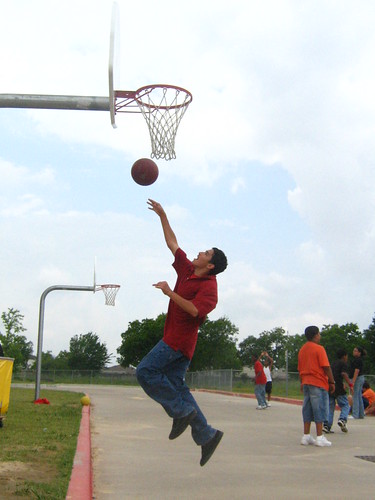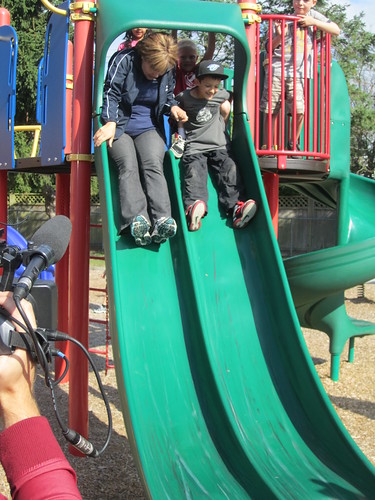One of the bills I have been advocating for is Bill 110 - a provision that will allow school property in Kentucky to be made available for the community to use to be more physically active. A bill that would allow schools to open up their playgrounds to children on the weekends, or their halls to walking programs in the winter, without the worry of liabilities.
Before I even started this blog, I spoke to my Community Nutrition class about the importance of this piece of legislature.
 |
Students enjoy an after school game
by Gwen |
Well, we did it! Senate Bill 110 passed with overwhelming support this week! What a great was to end National Nutrition Month!
Labels: Advocacy in Action, Grassroots Movement, Policy
What is Nutrition in Education: Recess
If you ask any child what their favorite part of the school day is, they will invariably say "Recess!". Recess is an important part of the day for a number of reasons - children need to be active, they need to be social and they need an opportunity to blow off steam. It is not, like so many schools have done, developmentally appropriate to remove recess time from a child's day. Few adults are able to attend their focus to monotonous tasks all day, and having this expectation for children is purely irrational. Recess is not only important from a Nutrition in Education point of view- but from all aspects of development.
Rae Pica, a children’s physical activity specialist provides 7 fantastic reasons why all children (and especially those with behavioral problems) need to have recess.
- Everyone benefits
from a break.
- Recess increases
on-task time.
- Children need
outside light to regulate the biological clock, improve move, support the immune system and to synthesis Vitamin D.
- Unstructured
physical play reduces stress.
- Children need to
learn to be social creatures.
- Our children’s
health is at risk when they do not have an opportunity to be physically active, regardless of weight status.
- Physical activity
feeds the brain.
Unfortunately, there is a trend in the United States towards "no-recess" policies in elementary and middle schools. School districts in Atlanta, New Jersey, Chicago, New York and Connecticut are among those implementing such polices - some to the point that playgrounds are no longer being built on new school properties.Other districts, including those in Georgia, Pennsylvania, Illinois, Texas, New Jersey, California and Florida are implementing reduction or elimination plans.
Frequently, it is cited that children do no need recess because they have physical education classes. However, this is not true for a number of reasons. Numerous studies have shown that children are simply not as physically active during PE as they are at Recess - frequently because of the utilization of team sports, such as baseball, by PE teachers in which many children stand and watch while 5-6 children are physically active. One study showed that in 30 minutes of a physical education class, the average child is only vigorously active for about 2 minutes. Not to mention that PE is a class, which means it deprives children of the social aspects of recess that are so important for their development.
Structured recess has been shown to increase physical activity among children. Structured recess is a concept in which teachers initiate and supervise games which encourage children to be active during recess. Playworks, a company that helps teach students and teachers how to encourage active play in the playground, helps explain the impact of structured play in the video below.
Resources:
S. J. Silverman and C. Dennis (2003). Student Learning in Physical Education: Applying Research to Enhance Instruction
Bazaliaki, N., Cox, D., Long, T., Risteen, J., Sparks, K., Ward, K. J. (n.d.). No recess- no way: Take back your time. Retrieved from http://www.timeday.org/pdf/recess_ban_paper.pdf
Pica, R. (n.d.) 7 reasons why kids need recess. Retrieved from http://www.movingandlearning.com/Resources/Articles30.htm
Pemerton, T. (2011). Oklahoma City schools try structured recess. Retrieved from http://newsok.com/oklahoma-city-schools-try-structured-recess-program/article/3548973
Labels: What is Nutrition Education
What is Nutrition in Education: School Food Environment
The school environment is a difficult concept to define, as it is a concept that seems fairly easily explained, but the more you examine the idea of school environment, the more expansive the concept becomes. The school environment encompasses the physical environment, the policies and procedures that shape the proceedings of the school and the attitudes attached to these proceedings. Not all aspects of the school environment are tangible, but a great many of them have an impact on healthy eating and physical activity of the students in which they preside.
 |
Visually appealing healthy foods promote healthy food choices
by USDAgov |
The CDC defines a healthy school environment as the physical and aesthetic surroundings and the psychological climate and culture of the school. Wechsler et al. further explain that environmental factors may be social, institutional or physical. Examples of social environment include role modeling and social norms (which can be defined by our peers, family or the media). Institutional factors include rules and polices, while physical factors include appearance and physical structures.
One of the most obvious aspects of the school environment, and one that we have discussed previous in this blog, is the availability of vending machines. At first glance, a vending machine is quite apparent as a physical structure. However, it is also an element of the school environment that is actively decided upon, meaning a policies exists as to when, if and how students can access the machine. How peers use the machine also has an affect on student uses. Suddenly a vending machine, which naturally has a direct impact on the dietary habits of students has numerous complexities in relationship to its involvement in the school environment.
 |
Children play more vigorously during recess when teachers engage them in play
by BC Gov Photos |
Environmental interventions are designed to (1) provide access to opportunities for engaging in health-enhancing behavior, while eliminating or weakening those aspects of the environment that make it easier for individuals to engage in health-compromising behavior, and (2) highlight positive role models, generate social support, and establish rewards and cues to action for engaging in health-enhancing behaviors.
- Wechsler et al.
I believe at this point there is no doubt in your mind that I could not possibly cover all the innumerable interventions to the school environment that could be made in order to improve health and physical activity behaviors of our school-bound youth, however, here are a couple of examples.
- Verstraete et al. found moderate physical activity can be increased in elementary children from 38 to 50% simply by providing children with play equipment such as balls, flying discs, skipping ropes, juggling equipment, and badminton ratchets and having teachers encourage use of equipment.
- Reicks et al have found that exposing children to photography of vegetables increases lunch line selection.
- Wechsler et. al examined the school food environment and found a number of environmental interventions that can improve physical activity and healthy eating behaviors
- There was a significant decrease in plate waste (children ate more of their lunch) when recess was scheduled before lunch.
- Access to school property such as gyms, basket ball and tennis courts outside of school hours increase physical activity and decreased juvenile crime. (This is a good reason to support Senate Bill 110!)
- 88% of high schools , 61% of middle schools, and 14%of elementary schools had food or beverage vending machines that students were allowed to use.
By reducing the price of nutrient dense foods in vending machines by 50%, sales of these food items increased from 26-46% of all sales.
Sources:
Centers for Disease Control and Prevention. Guidelines for school and community programs to promote lifelong physical activity among young people. MMWR 1997;46 (No. RR-6)
Verstraete, S J, Cardon, G M, De Clercq, D L , De Bourdeaudhuij, I M M, (2006). Increasing children’s physical activity levels during recess periods in elementary schools: The effects of providing game equipment. European Journal of Public Health, 16:4, 415–9.
Wechsler H., Devereaux, R. S., Davis, M., Collins, J. (2000). Using the school environment to promote physical activity and healthy eating. Preventive Mdicine, 31, S121-37.
Reicks, M, Redden, J P, Mann, T, Mykerezi, E, Vickers, Z, (2012). Photographs in lunch tray compartments and vegetable consumption among children in elementary school cafeterias. JAMA. 2012;307(8):784-785.
Labels: What is Nutrition Education
Now Playing: Happy National Registered Dietitian Day
For National Dietitians Day I thought it would be nice to celebrate a Community Nutrition graduate who is working to improve school nutrition and student nutrition knowledge here in Kentucky. Austin Dacci, the nutrition coordinator and school liaison for Harrison County school, has recently piloted a program to encourage middle and high school students to eat breakfast.
Noticing that the numbers for breakfast were low, with as few as 130 of the 1,000 high school student body, and 105 of 700 middle students participating in the school breakfast program, despite the district having a 57% free/reduced lunch rate, Austin conducted a student survey. The results showed that most students were skipping breakfast in favor of socializing before classes began. It became apparent that there needed to be a way to socialize while still fueling up for the day.
Austin's solution? Breakfast Grab-n-Go! This past week a trail went ahead with the following menu:
- Monday: Whole grain biscuit and low fat/ low sodium gravy in a bowl
- Tuesday: Yoghurt and berry parfait
- Wednesday: Egg, cheese an turkey English muffin
- Thursday: Mini pancake bites
- Friday: PB & J wrap with rice cereal for crunch
I followed up with Austin after the trail week was completed, and was pleased to hear that the high school saw a 15% increase in breakfast participation, and 10% increase in the middle school. These numbers should help support this pilot program becoming a regular thing, and as the word gets out, we hope these numbers will continue to grow.
Ensuring the students of his district are encouraged to eat breakfast, and hopefully learn to recognize the importance of this first meal is not Austins only project this month.National Nutrition Month shares March with another great cause - Read Across America Day. Austin participated by reading nutrition themed books with his students.
Austin is also incorporating nutrition into everyday classroom lesson plans. For example, fractions is math core academic requirement for all Kentucky third grade students. But instead of using scissors to cut out paper circles into various slices, the 3rd graders of Harrison County will be rolling pizza cutters. "We will be learning fractions, all while making home made pizzas," said Austin. "I know
its not super healthy, but it does teach them measuring, portion
control, and family consumer sciences." And perhaps more importantly, it teaches students cooking skills that they will be able to utilities for a lifetime.
 |
| One Half is the same as Three Sixths |
Austin is doing a great job of integrating the many facets of dietetics into the school environment, from the cafeteria to the classroom. I hope that many other dietitians involved in school food services follow in his footsteps!
Sources: Austin Dacci
Trying grab-n-go breakfasts to bolster student productivity
Labels: Now Playing
Advocacy in Action: Footpaths = A Healthy Future
Today, the American Heart Association is pushing the Safe Route to School bill, in person, on the fax-lines and over the phone. The message the AHA is promoting is “give America’s kids the right of way to a healthy life” by preserving the program in the federal transportation bill.
Walking is a great way to promote health, and walking to school is a fantastic way for children to be more active. Any grandparent will tell you they walked 15 miles, bare foot, up hill both ways to school! While this is (usually) an exaggeration, it is part of what kept our older generations healthy. In their school-days, children were able to walk to school, even if there were no footpaths, because the roads were less congested, and drivers much more conscious of pedestrians, as they were commonplace. Today, with out footpaths, it is simply unsafe for children to walk. For the vast majority of Kentucky, these footpaths do not exist.

The fate of Safe Routes to School, which helps communities build safe
sidewalks, crosswalks, and bike paths that allow kids to be more
physically active, is still up in the air. But thanks to your action, we
are making progress. Just last week, the Senate included a provision in
its transportation bill that would ensure that local governments and
school systems are able to access critical funds to make communities
safer for bicycling and walking. But our work is far from over until a
final bill is passed and signed.
- Clarissa Garcia, AHA
Today I have done my part by faxing Representative Chandler and Senators McConnell and Paul the document above. You too can download the fax and personalize it with your own details by
clicking here, to send to your Representatives and Senators, or you can call the Capitol switchboard
(202-224-3121) to connect with your legislators.
Labels: Advocacy in Action
March is National Nutrition Month!
This year the theme for national nutrition month is "Get Your Plate In Shape".
A fun Friday afternoon activity to "Get Your Plate In Shape" can be to give each child a paper plate, with a small blue circle attached to the top right of the plate (to represent dairy) along with access to food magazines. Allow them to cut out and paste foods from the groups and place them in the correct area on the plate - help them with the division of the plate.
For older children, The Academy of Nutrition and Dietetics suggests conducting a Fear Factor-type event. Provide unusual vegetables and fruits cut into bite-size pieces. Offer an opportunity to taste and guess the food. This is an activity I have personally done with children from first through twelfth grades, and they LOVE the dare aspect of it - and believe it or not, many are surprised to find that they like a new food or two! If weird vegetables are a little daunting, the activity also works well with fruit and vegetable juices.
More fun suggestions from the Academy for involving children in National Nutrition Month
can be found here! Labels: Grassroots Movement






